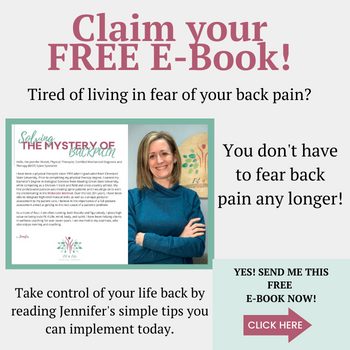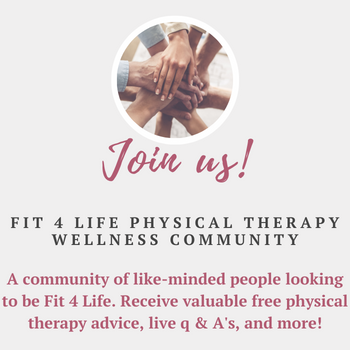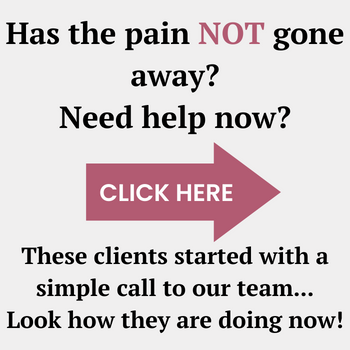How does this history sound?
“My pain started last fall sometime. I didn’t really do anything I can thing remember, it just started aching. It’s not there all the time, I can’t sit very long, certainly can’t drive long distances. I am ok walking as long as I like. A lot of the time my pain actually gets worse after an activity, like when I come home and relax. It’s worse in the morning for sure, I feel stiff and can’t bend over to brush my teeth or put my socks on. OH…and when I cough or sneeze! OUCH! It’s not getting better. I can no longer exercise like I want to and it’s impacting my quality of life. It’s happened a few times in my life before, sometimes after I’ve been doing a lot of bending, but it always got better.”
This is such a common history, one I might hear weekly as a Physical Therapist. Can I be honest with you? When someone presents with this history, especially if they are in the 30-55 age range, I get excited. I know…call me crazy. Yet I know I can help this person and the things I teach them will literally blow their mind and change their life.
The evaluation of a patient with this history is pretty specific in my office. I ask a lot of questions…a lot. I need to understand the pain, your pain. Then we move, very specifically and intentionally. I will watch you forward bend, backward bend, move your hips side to side. I’ll check your strength, your reflexes, your sensation, then we test repeated movements.
Most of the time we begin with forward bending in standing. I watch your range of motion and you describe the pain and how it responds. Then we try backward bending in standing, same observations and responses noted. Next you will lay down on treatment table and we repeat bringing your knees up to your chest. Many people do try this to stretch their backs before they see me. Once again, we assess how your pain responds to the movement, especially when you get up from the table. Finally we look at backward bending while laying on your stomach. Most people are afraid of this one, or have never done it, or they struggle with it because their arms are weak! Nevertheless, this movement is often the money maker for this patient.
In this situation, when low back pain responds to backward bending, or extension, we have lots of education to do. If you were sitting in my office, it would go something like this:
Jen : “I am so excited because you are going to do GREAT. You have a disc bulge causing your pain…”
Patient: “I have a disc bulge? Wait, that’s bad. Am I gonna need surgery? My mom has a bad back, degenerative discs and all, is that what I have? Do I need an MRI or an injection?”
Jen: “slow down friend. You are gonna be just fine. This is actually such good news because I can treat this! Remember when we did those back bends on the table? They took your pain away right? We can get it to stay away if you do just as I say. Can you do that?
Patient: “I’ll do whatever you say!”
Jen: “Ok good. So here is the true story. People are afraid of the words disc problem, disc bulge, or disc herniation. I, on the other hand, am not. I love this problem because I know I can fix it, MOST of the time. Bony, arthritis, narrowing, stenosis, I cannot change those things and those patients don’t’ respond quite as nicely to stretching as you will. Here is the story: We bend 3,000-5,000x a day forward. How often do you bend backward? Like zero. So your spine is out of balance. Your spine is made up of bones and discs. The discs are little shock absorbers. Let’s just say they resemble jelly donuts. They have a firm circular anulus that is supposed to hold that jelly in the center, the nucleus, in place. When we repeatedly forward bend, that jelly starts to move. You see, forward bending compresses the front side of the disc, gapping the back. The jelly moves to the back of the disc where there is more room! Eventually it shifts over to the left or right if you keep bending where it will come in contact with the nerves as they leave the spinal cord and head out into the body. The location of your pain depends on which disc is the one, or two, that are pinching the nerve.

And so we need to stop forward bending! You are going to backward bend a ton…like 4-6 x a day. Your back may be sore, your arms will be sore! But if we can turn off that pain, and keep it off, your back will form a little scab over that injury and it will heal. So think about a bent knuckle. If you have a cut on your knuckle and you keep bending, it won’t heal, right? So we put a Band-Aid on it, stop bending it for a bit, it heals up, and then you are good to go. Same will apply here for your back.
The hardest thing you will have to do for the next few days is not bend. You are gonna need to sit up straight and use this thing called a lumbar roll all the time. You’ll have to squat when you want to pick something up, and I’ll teach you how to sleep with your bottom leg straight on your side (no more fetal position). We have a lot to work on but you will do great. How does this sound?”



So give this move a try, 10 -15 reps, every 2 hours, for the next few days and report back with how you are feeling.”

You don’t have to fear a disc problem friend. You need a good Physical Therapist who will take time to listen to your story, watch you move, show you what to do, teach you what not to do, and most of all, empower you to take control of your life. Your back pain doesn’t have to control you. You can have your life back.
Disclaimer, this blog post does not replace your personal evaluation by a skilled Physical Therapist. This movement will not help all low back pain and in some situations it may make you worse. Call for your personal evaluation today.
Jennifer Nieset, PT, Cert MDT
Owner
Fit 4 Life Physical Therapy
7575 Fredle Dr. Suite B2
Concord, Oh 44077
440-340-3717







I was suggested this website by my cousin. I’m not positive whether or not this put
up is written by means of him as nobody else realize such specified about my trouble.
You are incredible! Thanks!
bookmarked!!, I really like your site!
Hello, yeah this post is in fact fastidious and I have learned lot of things from it about blogging.
thanks.
Very good article! We are linking to this great post on our website.
Keep up the great writing.
We are a group of volunteers and starting a new scheme in our community.
Your site provided us with valuable information to work on. You’ve done a formidable job and our whole community will be grateful to
you.
Outstanding story there. What occurred after? Good luck!
Good post! We will be linking to this particularly great
content on our site. Keep up the good writing.
Attractive component of content. I just stumbled
upon your weblog and in accession capital to assert that I get actually loved account your blog posts.
Anyway I’ll be subscribing for your augment or even I success
you get admission to constantly fast.
Good day! I simply would like to give you a big
thumbs up for the excellent information you have got here on this post.
I will be coming back to your site for more soon.
Its like you read my mind! You appear to know a lot about this,
like you wrote the book in it or something. I think that you could do with some
pics to drive the message home a little bit, but other than that, this is magnificent
blog. A fantastic read. I’ll certainly be
back.
Hi there, I enjoy reading all of your article. I wanted to
write a little comment to support you.